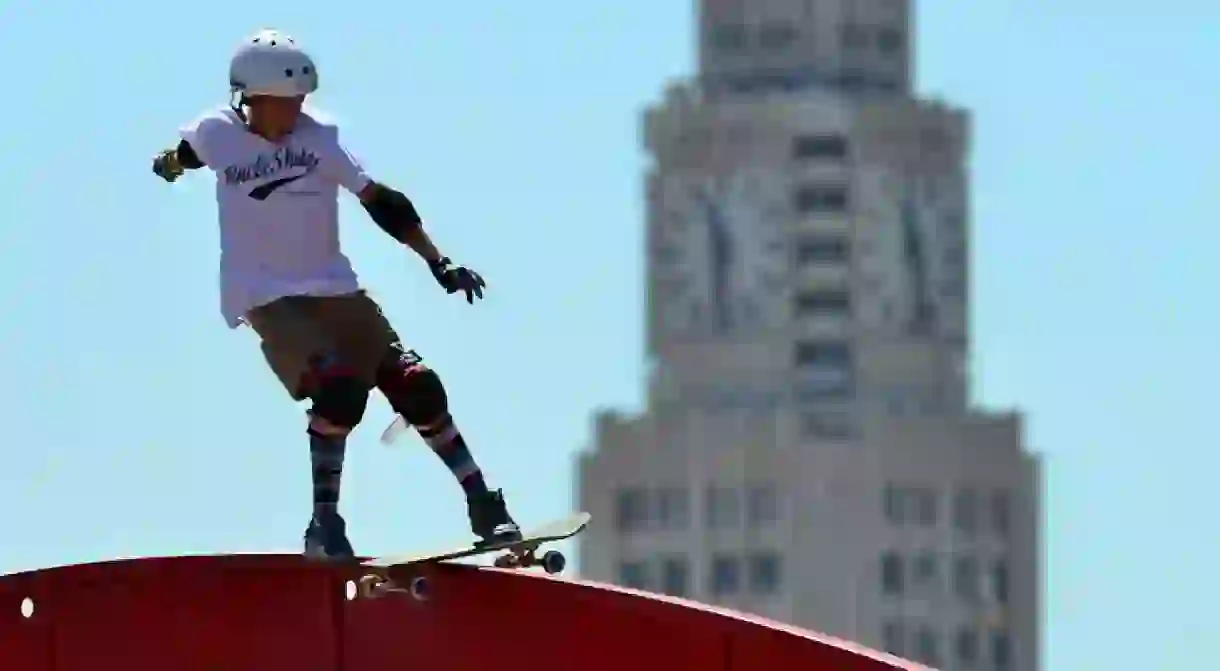How Skateboarding Carved A Place In Mainstream Style

Over the last 20 years, skate wear has evolved from outsider to owner–nay, Lord, of the mainstream aesthetic. Yet as the culture has developed, so has the cult within it. In spite of their widened availability, you are now more likely to see queues winding down the block to get a piece of limited edition skate clothing than at any other point in history. We investigate the influence of skateboarding on mainstream fashion.
In 2005, director Catherine Hardwicke released Lords of Dogtown, which chronicled the antics of the Zephyr competition team (the Z–boys) over one summer in the 1970s. Based on a true story, it documents the beginnings of skate legends Tony Alva, Stacy Peralta and Jay Adams. Lords of Dogtown was an instant cult classic, an ode to the freedom that skateboarding brings, as well as a celebration of the free-wheeling, badass spirit of being in a pack of teenage boys. The documentary about the Zephyr team was also nominated for Sundance Festival.
http://instagram.com/p/BEbLVubm5Ob/?taken-by=supremenewyork
Clothing is the embodiment of this skater spirit. In the film, boys wear oversized tee-shirts, backwards caps, hoodies, shorts and low-slung jeans–a style that has barely changed since the 70s. The loose fitting, oversized items give riders the freedom to skate how they want, while conveying a carefree, understated aesthetic.
As such, the skater attitude has proven to be infinitely seductive to brands looking to commender the spirit for their own gains. And one of the reasons that skate wear has become mainstream is undoubtably due to branding. Corporate giants such as Red Bull have taken the sport and seamlessly aligned with it, ensuring mass proliferation of what was more of an outsider game. But the supremacy of the brands on the scene today stems from their authenticity. And amongst a clan of heavy hitters, there are two main giants who stand shoulders above the rest: Supreme and Stussy.
http://instagram.com/p/2pDQjjRVHR/?taken-by=biancachandon&hl=en
Supreme’s first store was opened in 1994 in downtown NYC. Founder James Jebbia was a savvy entrepreneur who understood that skate kids were discerning customers, picky about what they wore. Jebbia hired local skaters to work in his store, cultivating an authentic brand, and loyal fanbase. ‘We’re just trying to make stuff for that real pain-in-the-ass, picky New York kid.’ Jebbia told Interview magazine.
Stussy was founded in 1980s California by Shawn Stüssy and partner Frank Sinatra (no, not that one). The duo came from a background of surfing and skateboarding, but drew on high fashion from the beginning. Stüssy No.4 paid homage to Chanel’s iconic perfume, as did the logo made from interlocking S’s. The marriage of influences allowed the brand to create something new and energetic, gaining a dedicated and international following within only a few years.
Stussy not only inspired Supreme, but also the legions of styles that followed–Bianca Chandon, Mood and Palace to name a few. These brands command huge audiences, with international stores and stockists. Cruising from the outer echelons of style into the heart of the contemporary aesthetic, they continue to monopolise the same attitude, but also speak to a generation in a way that is more relevant than their high fashion counterparts.
http://instagram.com/p/BIm7JKmg-Vt/?taken-by=palaceskateboards&hl=en
In an age of constant collections and the instant dissipation of catwalk trends, Supreme and company have nailed the exclusive edge, combining high quality design with accessible price points. Having started by drawing on what they know and the culture around them, these brands have now developed a savviness for limited edition collections and smart collaborations with a mix of labels, from Levis, to North Face and Larry Clark, while still staying true to their ethos. These brands are expensive, but they’re not couture expensive: this is the high fashion that a new generation can wear.
Beyond the labels themselves, skate wear brands have also mastered the nature of the concept store. The attitude seamlessly pervades throughout the experience of the label. And amazingly, the attitude is maintained on their websites too. Online, Supreme’s layout allows you to navigate, but gives the minimal amount of content. The brand’s ‘cool’ factor is located in the mystery.
http://instagram.com/p/BFr2BVFG4mR/?taken-by=moodnyc
To be a hipster now, is to be a millennial. There’s nothing alternative about the fashion options here. But skate wear continues to offer something more individual, even as it starts getting sold on Urban Outfitters. Indeed, as the cult of skater style develops into a contemporary culture, it will be interesting to see how these brands cope with such fervent and sustained admiration. One thing’s for sure, they won’t be pushed back to the skate parks anytime soon.













